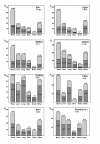Breast cancer biological subtypes and protein expression predict for the preferential distant metastasis sites: a nationwide cohort study
- PMID: 21914172
- PMCID: PMC3262199
- DOI: 10.1186/bcr2944
Breast cancer biological subtypes and protein expression predict for the preferential distant metastasis sites: a nationwide cohort study
Abstract
Introduction: Some molecular subtypes of breast cancer have preferential sites of distant relapse. The protein expression pattern of the primary tumor may influence the first distant metastasis site.
Methods: We identified from the files of the Finnish Cancer Registry patients diagnosed with breast cancer in five geographical regions Finland in 1991-1992, reviewed the hospital case records, and collected primary tumor tissue. Out of the 2,032 cases identified, 234 developed distant metastases after a median follow-up time of 2.7 years and had the first metastatic site documented (a total of 321 sites). Primary tumor microarray (TMA) cores were analyzed for 17 proteins using immunohistochemistry and for erbB2 using chromogenic in situ hybridization, and their associations with the first metastasis site were examined. The cancers were classified into luminal A, luminal B, HER2+ enriched, basal-like or non-expressor subtypes.
Results: A total of 3,886 TMA cores were analyzed. Luminal A cancers had a propensity to give rise first to bone metastases, HER2-enriched cancers to liver and lung metastases, and basal type cancers to liver and brain metastases. Primary tumors that gave first rise to bone metastases expressed frequently estrogen receptor (ER) and SNAI1 (SNAIL) and rarely COX2 and HER2, tumors with first metastases in the liver expressed infrequently SNAI1, those with lung metastases expressed frequently the epidermal growth factor receptor (EGFR), cytokeratin-5 (CK5) and HER2, and infrequently progesterone receptor (PgR), tumors with early skin metastases expressed infrequently E-cadherin, and breast tumors with first metastases in the brain expressed nestin, prominin-1 and CK5 and infrequently ER and PgR.
Conclusions: Breast tumor biological subtypes have a tendency to give rise to first distant metastases at certain body sites. Several primary tumor proteins were associated with homing of breast cancer cells.
Figures



Similar articles
-
Receptor conversion in distant breast cancer metastases.Breast Cancer Res. 2010;12(5):R75. doi: 10.1186/bcr2645. Epub 2010 Sep 23. Breast Cancer Res. 2010. PMID: 20863372 Free PMC article.
-
Luminal breast cancer metastases and tumor arousal from dormancy are promoted by direct actions of estradiol and progesterone on the malignant cells.Breast Cancer Res. 2014 Dec 5;16(6):489. doi: 10.1186/s13058-014-0489-4. Breast Cancer Res. 2014. PMID: 25475897 Free PMC article.
-
Impact of estrogen receptor (ER) and human epidermal growth factor receptor-2 (HER2) co-expression on breast cancer disease characteristics: implications for tumor biology and research.Breast Cancer Res Treat. 2014 Nov;148(2):437-44. doi: 10.1007/s10549-014-3145-x. Epub 2014 Sep 26. Breast Cancer Res Treat. 2014. PMID: 25257728
-
Molecular and cellular mechanisms underlying brain metastasis of breast cancer.Cancer Metastasis Rev. 2020 Sep;39(3):711-720. doi: 10.1007/s10555-020-09881-y. Cancer Metastasis Rev. 2020. PMID: 32399646 Free PMC article. Review.
-
The value of biomarkers in bone metastasis.Eur J Cancer Care (Engl). 2017 Nov;26(6). doi: 10.1111/ecc.12725. Epub 2017 Jun 27. Eur J Cancer Care (Engl). 2017. PMID: 28653449 Review.
Cited by
-
Triple-negative breast cancer: is there a treatment on the horizon?Oncotarget. 2017 Jan 3;8(1):1913-1924. doi: 10.18632/oncotarget.12284. Oncotarget. 2017. PMID: 27765921 Free PMC article. Review.
-
Catalase abrogates β-lapachone-induced PARP1 hyperactivation-directed programmed necrosis in NQO1-positive breast cancers.Mol Cancer Ther. 2013 Oct;12(10):2110-20. doi: 10.1158/1535-7163.MCT-12-0962. Epub 2013 Jul 24. Mol Cancer Ther. 2013. PMID: 23883585 Free PMC article.
-
Immunohistochemical Predictors of Bone Metastases in Breast Cancer Patients.Pathol Oncol Res. 2015 Sep;21(4):1229-36. doi: 10.1007/s12253-015-9957-0. Epub 2015 Jun 11. Pathol Oncol Res. 2015. PMID: 26062800 Free PMC article.
-
Elevated Expression of RIOK1 Is Correlated with Breast Cancer Hormone Receptor Status and Promotes Cancer Progression.Cancer Res Treat. 2020 Oct;52(4):1067-1083. doi: 10.4143/crt.2020.187. Epub 2020 May 8. Cancer Res Treat. 2020. PMID: 32599985 Free PMC article.
-
Clinical outcomes and a nomogram for de novo metastatic breast cancer with lung metastasis: a population-based study.Sci Rep. 2022 Mar 4;12(1):3597. doi: 10.1038/s41598-022-07565-x. Sci Rep. 2022. PMID: 35246585 Free PMC article. Clinical Trial.
References
-
- Parkin DM, Bray F, Ferlay J, Pisani P. Global cancer statistics, 2002. CA Cancer J Clin. 2002;55:74–108. - PubMed
-
- Largillier R, Ferrero JM, Doyen J, Barriere J, Namer M, Mari V, Courdi A, Hannoun-Levi JM, Ettore F, Birtwisle-Peyrottes I, Balu-Maestro C, Marcy PY, Raoust I, Lallement M, Chamorey E. Prognostic factors in 1038 women with metastatic breast cancer. Annals of Oncology. 2008;19:2012–2019. doi: 10.1093/annonc/mdn424. - DOI - PMC - PubMed
-
- van de Vijver MJ, He YD, van't Veer LJ, Dai H, Hart AA, Voskuil DW, Schreiber GJ, Peterse JL, Roberts C, Marton MJ, Parrish M, Atsma D, Witteveen A, Glas A, Delahaye L, van der Velde T, Bartelink H, Rodenhuis S, Rutgers ET, Friend SH, Bernards R. A gene-expression signature as a predictor of survival in breast cancer. N Engl J Med. 2002;347:1999–2009. doi: 10.1056/NEJMoa021967. - DOI - PubMed
Publication types
MeSH terms
Substances
LinkOut - more resources
Full Text Sources
Other Literature Sources
Medical
Research Materials
Miscellaneous

